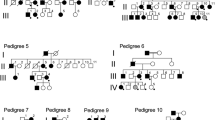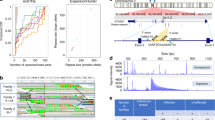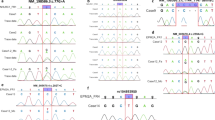Abstract
Progressive myoclonus epilepsy type 1 (EPM1, also known as Unverricht-Lundborg disease) is an autosomal recessive disorder characterized by progressively worsening myoclonic jerks, frequent generalized tonic-clonic seizures, and a slowly progressive decline in cognition1. Recently, two mutations in the cystatin B gene (also known as stefin B, STFB) mapping to 21q22.3 have been implicated in the EPM1 phenotype: a G→C substitution in the last nucleotide of intron 1 that was predicted to cause a splicing defect in one family, and a C→T substitution that would change an Arg codon (CGA) to a stop codon (TGA) at amino acid position 68, resulting in a truncated cystatin B protein in two other families2. A fourth family showed undetectable amounts of STFB mRNA by northern blot analysis in an affected individual. We present haplotype and mutational analyses of our collection of 20 unrelated EPM1 patients and families from different ethnic groups. We identify four different mutations, the most common of which consists of an unstable ∼600–900 bp insertion which is resistant to PCR amplification. This insertion maps to a 12-bp polymorphic tandem repeat located in the 5' flanking region of the STFB gene, in the region of the promoter. The size of the insertion varies between different EPM1 chromosomes sharing a common haplotype and a common origin, suggesting some level of meiotic instability over the course of many generations. This dynamic mutation, which appears distinct from conventional trinucleotide repeat expansions, may arise via a novel mechanism related to the instability of tandemly repeated sequences.
This is a preview of subscription content, access via your institution
Access options
Subscribe to this journal
Receive 12 print issues and online access
$209.00 per year
only $17.42 per issue
Buy this article
- Purchase on Springer Link
- Instant access to full article PDF
Prices may be subject to local taxes which are calculated during checkout
Similar content being viewed by others
References
Marseille Consensus Group. Classification of progressive myoclonus epilepsies and related disorders. Ann. Neurol. 28, 113–116 (1990).
Pennacchio, L.A. et al. Mutations in the gene encoding cystatin B in progressive myoclonus epilepsy (EPM1). Science 271, 1731–1734 (1996).
Cochius, J.I. et al. Unverricht-Lundborg disease: absence of nonallelic genetic heterogeneity. Ann. Neurol. 34, 739–741 (1993).
Lafrenière, R.G. de Jong, P.J. & Rouleau, G.A. A 405-kb cosmid contig and Hindlll restriction map of the progressive myoclonus epilepsy type 1 (EPM1) candidate region in 21q22.3. Genomics 29, 288–290 (1995).
Genton, P. Michelucci, R. Tassinari, C.A. & Roger, J. The Ramsey Hunt syndrome revisited: Mediterranean myoclonus versus mitochondrial encephalomyopathy with ragged-red fibers and Baltic myoclonus. Acta Neurol. Scand. 81, 8–15 (1990).
Andermann, F. Berkovic, S. Carpenter, S. & Andermann, E. Ramsay-Hunt syndrome is no longer a useful diagnostic category. Movement Disorders 4, 13–17 (1989).
Oberle, I. et al. Instability of a 550-basepair DNA segment and abnormal methylation in Fragile X Syndrome. Science 252, 1097–1102 (1991).
Kremer, E.J. et al. Mapping of DNA instability at the fragile X to a trinucleotide repeat sequence p(CCG)n. Science 252, 1711–1714 (1991).
Verkerk, A.J.M.H. et al. Identification of a gene (FMR-1) containing a CGG repeat coincident with a breakpoint cluster region exhibiting variation in Fragile X syndrome. Cell 65, 905–914 (1991).
Fu, Y.-H. et al. Variation of the CGG repeat at the fragile X site results in genetic instability: resolution of the Sherman paradox. Cell 67, 1047–1058 (1991).
Pedersen, E. et al. Familial progressive myoclonic epilepsy: a clinical, genetical, biochemical and patho-anatomical study of a family with a 6-year follow-up. J. Neurolog. Sci. 53, 305–320 (1982).
Avramopoulos, D. Cox, T. Kraus, J.P. Chakravarti, A. & Antonarakis, S.E. Linkage mapping of the cystathionine B-synthase (CBS) gene on human chromosome 21 using a DNA polymorphism in the 3′ untranslated region. Hum. Genet. 90, 566–568 (1993).
Polymeropoulos, M.H. Rath, D.S. Xiao, H. & Merril, C.R. Dinucleotide repeat polymorphism at the human liver-type phosphofructokinase (PFKL) gene. Nucl. Acids Res. 19 2517 (1991).
Petersen, M.B. et al. Linkage mapping of D21S171 to the distal long arm of human chromosome 21 using a polymorphic (AC)n dinucleotide repeat. Hum. Genet. 87, 401–404 (1991).
Munke, M. et al. Regional assignment of six polymorphic DNA sequences on chromosome 21 by in situ hybridization to normal and rearranged chromosomes. Am. J. Hum. Genet. 42, 542–549 (1988).
Dib, C. et al. A comprehensive genetic map of the human genome based on 5,264 microsatellites. Nature 380, 152–154 (1996).
Yaspo, M.-L. et al. Model for a transcript map of human chromosome 21: isolation of new coding sequences from exon and enriched cDNA libraries. Hum. Mol. Genet. 4, 1291–1304 (1995).
Cheng, J.-F. Boyartchuk, V. & Zhu, Y. Isolation and mapping of human chromosome 21 cDNA: progress in constructing a chromosome 21 expression map. Genomics 23, 75–84 (1994).
Feinberg, A.P. & Vogelstein, B. A technique for radiolabeling DNA restriction endonuclease fragments to high specific activity. Anal. Biochem. 132, 6–13 (1983).
Ichikawa, H. et al. A Notl restriction map of the entire long arm of human chromosome 21. Nature Genet. 4, 361–366 (1993).
Author information
Authors and Affiliations
Corresponding author
Rights and permissions
About this article
Cite this article
Lafreniére, R., Rochefort, D., Chrétien, N. et al. Unstable insertion in the 5′ flanking region of the cystatin B gene is the most common mutation in progressive myoclonus epilepsy type 1, EPM1. Nat Genet 15, 298–302 (1997). https://doi.org/10.1038/ng0397-298
Received:
Accepted:
Issue Date:
DOI: https://doi.org/10.1038/ng0397-298
This article is cited by
-
Drug Treatment of Progressive Myoclonic Epilepsy
Pediatric Drugs (2020)
-
Tandem repeats mediating genetic plasticity in health and disease
Nature Reviews Genetics (2018)
-
Progressive myoclonic epilepsies: review of clinical, molecular and therapeutic aspects
Journal of Neurology (2010)
-
Cystatin B: mutation detection, alternative splicing and expression in progressive myclonus epilepsy of Unverricht-Lundborg type (EPM1) patients
European Journal of Human Genetics (2007)
-
Loss of lysosomal association of cystatin B proteins representing progressive myoclonus epilepsy, EPM1, mutations
European Journal of Human Genetics (2005)



